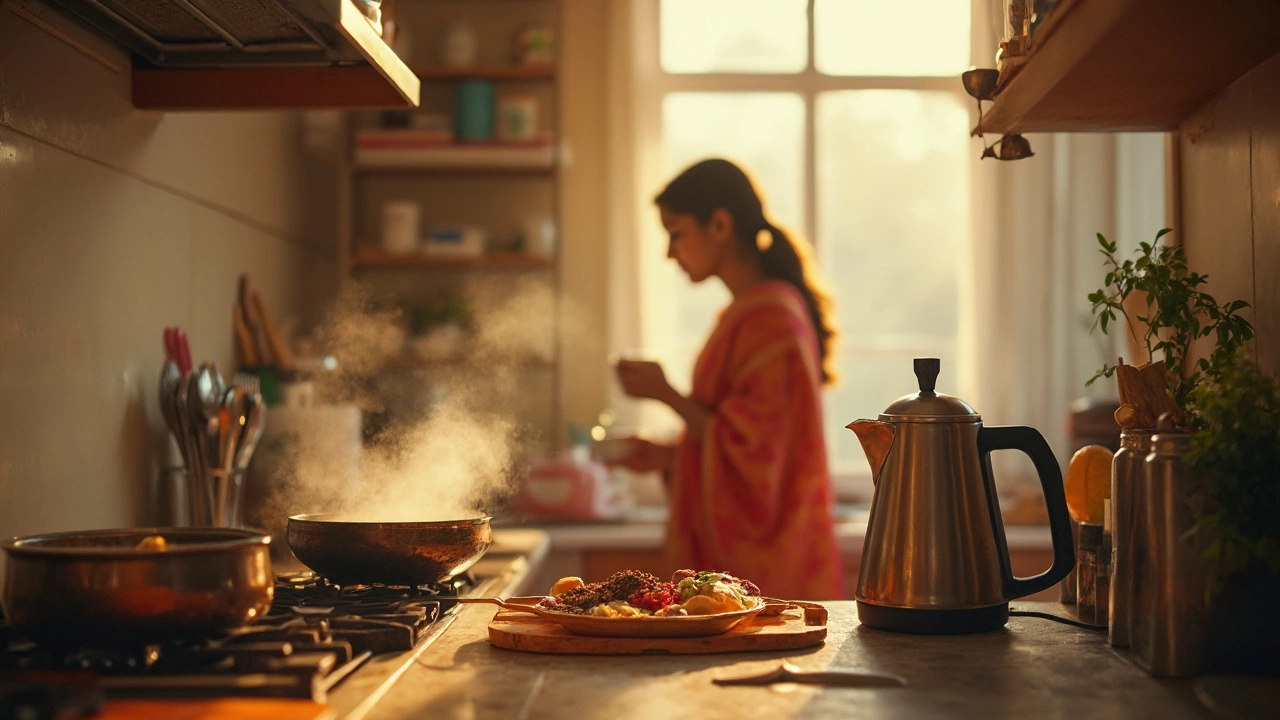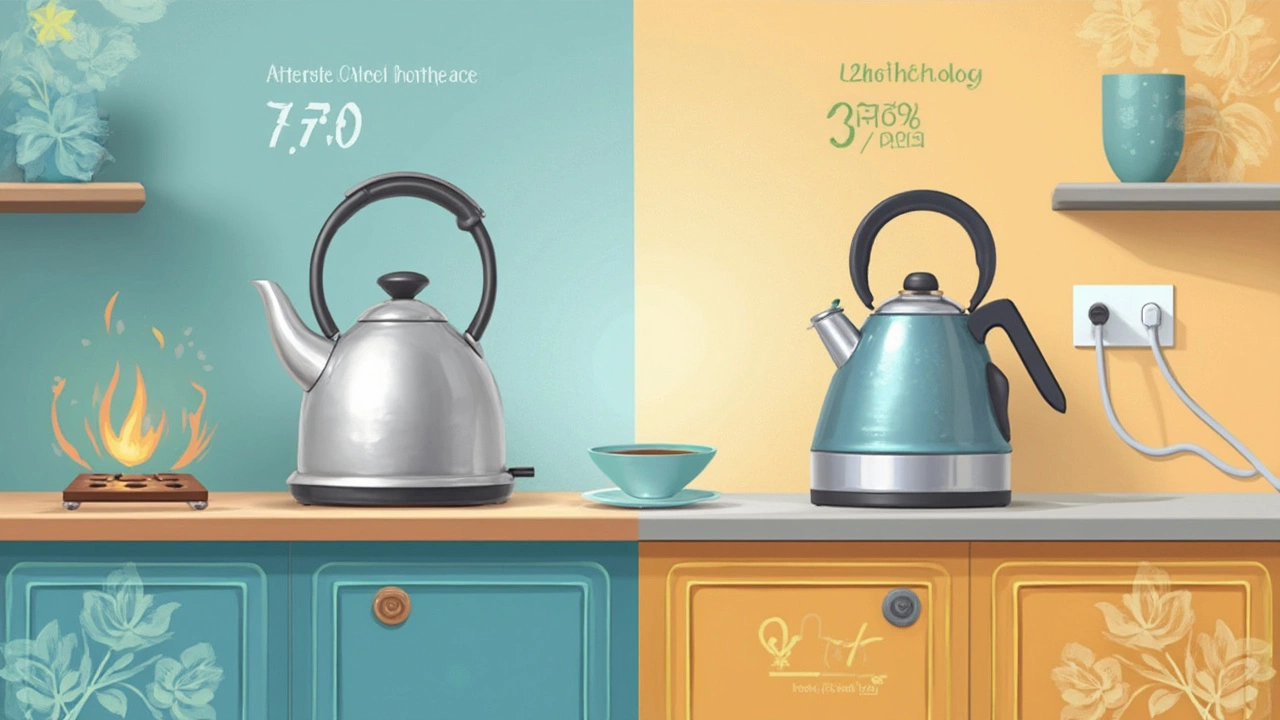
If you've ever stood there, watching a pot of water and wondering if an electric kettle is really worth it, you're not alone. We’re all looking for ways to save time (and maybe a little on the energy bill) just to get a cup of tea or coffee. Here’s the thing: electric kettles aren’t just a fancy gadget—they’re built to make your life easier, and most people are surprised at how much faster they work compared to an average stovetop.
But before you swap your saucepan for an electric kettle, it’s smart to know exactly what’s going on when you boil water both ways. Not all boils are equal! From heating times to the subtle differences in taste, the way you boil water actually matters more than most realize. Plenty of us just want the fastest cup possible, but there are other factors at play—like energy efficiency and cleanup.
- How Electric Kettles Work vs. Boiling on the Stove
- Which Is Faster and More Efficient?
- Cost and Energy Use
- Best Tips for Clean, Great-Tasting Water
How Electric Kettles Work vs. Boiling on the Stove
Both electric kettles and stove-top boiling get you hot water, but they do it in totally different ways. Here’s what actually happens: when you hit the switch on an electric kettle, an electric coil at the base heats up instantly. That metal coil transfers heat straight to the water. Water in a typical electric kettle boils pretty fast—often in under three minutes—because the heat goes right where it’s needed, and the lid keeps most of the steam (and energy) inside.
Now, if you’re using a pot or a traditional whistle kettle on the stove, things run a bit differently. Whether you use gas or electric burners, the heat first has to warm the metal of your pot or kettle. After that, heat passes from the metal to the water inside, but a lot of energy gets lost in the process—some escapes into the air, and some is absorbed by the stove itself.
- Electric kettles are purpose-built for one job—boiling water fast and efficiently.
- Kettles on the stove are usually thicker and lose heat from the metal and exposed sides, making them slower and less efficient.
If numbers matter to you, here’s a quick comparison of typical times and wattages:
| Method | Time to Boil (1L) | Power Used |
|---|---|---|
| Electric Kettle | 2-3 mins | 1500-3000W |
| Stovetop (Gas or Electric) | 5-10 mins | Usually much less efficient |
Here’s a fun tip: if you live somewhere with a lot of limescale in the tap water, electric kettles often gather buildup faster than stove-top pots because they heat up quicker and keep the minerals moving. Most have a removable filter screen to keep the junk out of your mug, though—even some of the cheap ones.
If you’re all about getting things done fast and hate waiting for your water to sing, the electric kettle is usually the winner. But, hey, if you enjoy the old-school whistling sound or like keeping an eye on your boil for a perfect French press, stove-top still does the job—it just takes a little more patience (and energy).
Which Is Faster and More Efficient?
Time is precious—especially when you just want your coffee right now. An electric kettle usually wins hands down for speed. Most modern kettles can bring a liter of water to a boil in under three minutes. Compare that to a basic stovetop kettle or pot, which often takes five to eight minutes for the same amount. That’s a pretty big time-saver, especially if you’re in a rush before work.
But why is an electric kettle so much faster? It’s all about direct contact. The heating element inside the kettle touches the water directly, delivering heat more efficiently. Meanwhile, on the stove, you lose heat to the air and your kitchen. So, more power goes into the water with a kettle, and less goes to waste.
Let’s talk energy. Using an electric kettle is usually more energy-efficient. A 2023 test by Consumer Reports found that kettles use about 80% of their electricity to actually heat the water, while stovetops (gas or electric) only get about 60-70% efficiency. That’s money saved every time you boil the kettle instead of the old pot.
| Method | Time to Boil 1 Liter | Efficiency |
|---|---|---|
| Electric Kettle | 2.5 - 3 min | ~80% |
| Stovetop (Gas) | 6 - 8 min | ~60% |
| Stovetop (Electric) | 5 - 7 min | ~70% |
Here’s another cool bit: most electric kettles turn themselves off right after the water boils. Forgetting a pot on the stove can mean wasted energy—or worse.
If you’re after speed and don’t want to waste electricity, an electric kettle is tough to beat. For anyone boiling water more than once a day, the time and energy savings add up fast. It’s a small kitchen upgrade that actually pays off.

Cost and Energy Use
If you're wondering which choice is cheaper and more energy-efficient, here’s how things break down. Electric kettles heat water quickly by sending electricity right to a coil or plate inside the kettle, and almost all the energy goes straight into the water. On the other hand, when you boil water on a stove, a good chunk of the heat is lost to the air or to the kettle itself, especially if you're using a gas burner.
On average, a modern electric kettle uses about 0.1 kWh to boil a liter of water. That’s less than a penny each time in most regions—seriously cheap. If you do this daily, you’ll still only spend a few bucks a year on your hot drinks. Contrast that with a stovetop: electric stoves use up to 25% more power, and gas stovetops lose even more due to how they spread heat.
| Method | Energy for 1L Boil | Typical Cost |
|---|---|---|
| Electric kettle | 0.1 kWh | $0.01 |
| Electric stove | 0.12-0.13 kWh | $0.012–$0.013 |
| Gas stove | 0.18-0.2 kWh | $0.018–$0.02 |
Another thing people forget: electric kettles shut off automatically when they hit the boil, so you don’t waste power or risk leaving it on. Stovetop boiling needs you to keep watch, or you’ll burn through gas or electricity just by getting distracted. Plus, if you only need a single mug, kettles let you heat exactly that amount—no extra energy spent boiling more than you want.
Want to squeeze out even more savings? Don’t overfill your kettle. If you’re just making one coffee, measure the water first. Overfilling means you’re using more energy for water you might not even use—which adds up if you do this several times a day.
Best Tips for Clean, Great-Tasting Water
The taste of your coffee or tea can only be as good as the water you start with. Whether you're using a stovetop or an electric kettle, the water itself—and how you handle your kettle—makes a bigger difference than you'd expect.
First rule: start with fresh, cold water. Tap water is usually fine, but if yours tastes funky on its own, your tea or coffee will too. Sometimes, hard water leaves mineral deposits in your electric kettle, making everything taste a bit off. A quick fix? Use filtered water if you can. This takes out weird flavors and prevents limescale build-up.
When it comes to the kettle, regular cleaning is non-negotiable. Those white crusty spots inside are limescale (calcium deposits), and they do more than just look gross—they mess with both flavor and kettle performance. Experts say descaling every couple of weeks can keep your kettle in top shape, especially if you’re in a hard water area.
- Mix equal parts white vinegar and water.
- Boil the solution in your kettle.
- Let it sit for 15-20 minutes, then rinse several times.
If you’re worried about lingering vinegar smells, do one final boil with just water. Most modern electric kettles these days even have a removable filter—don’t forget to check and clean this too. It helps catch little bits of scale before they hit your cup.
Want to see how hard your water is? Some areas have data available:
| City | Average Water Hardness (mg/L) |
|---|---|
| New York, NY | 62 |
| Los Angeles, CA | 127 |
| London, UK | 266 |
| Sydney, AU | 95 |
The higher that number, the more limescale you’ll get. If your water is on the high end, think about cleaning your kettle more often. And if you notice a stale smell or strange color in boiled water, it could be time to replace your water filter—or maybe give your kettle a serious deep clean.
Bottom line: fresh, cleaned-up water and a well-kept kettle mean better-tasting drinks. Paying attention to these basics will help you get the most out of your electric kettle every time.